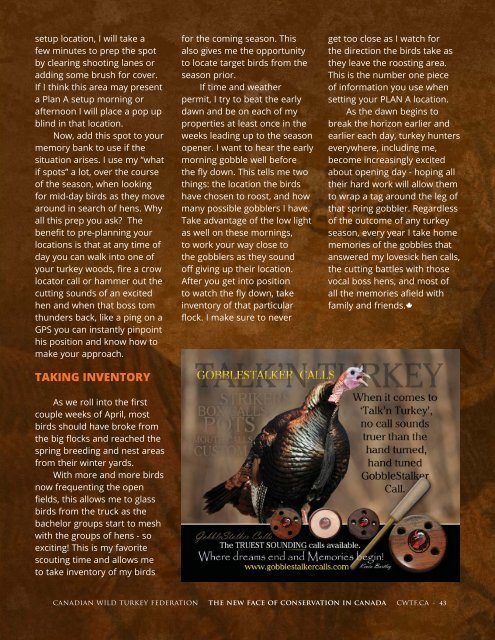CWTF 2017 Inaugural Member's Edition Magazine
CWTF is proud to share with you the Inaugural 2017 Member's Edition Magazine.
CWTF is proud to share with you the Inaugural 2017 Member's Edition Magazine.
Create successful ePaper yourself
Turn your PDF publications into a flip-book with our unique Google optimized e-Paper software.
setup location, I will take a<br />
few minutes to prep the spot<br />
by clearing shooting lanes or<br />
adding some brush for cover.<br />
If I think this area may present<br />
a Plan A setup morning or<br />
afternoon I will place a pop up<br />
blind in that location.<br />
Now, add this spot to your<br />
memory bank to use if the<br />
situation arises. I use my “what<br />
if spots” a lot, over the course<br />
of the season, when looking<br />
for mid-day birds as they move<br />
around in search of hens. Why<br />
all this prep you ask? The<br />
benefit to pre-planning your<br />
locations is that at any time of<br />
day you can walk into one of<br />
your turkey woods, fire a crow<br />
locator call or hammer out the<br />
cutting sounds of an excited<br />
hen and when that boss tom<br />
thunders back, like a ping on a<br />
GPS you can instantly pinpoint<br />
his position and know how to<br />
make your approach.<br />
TAKING INVENTORY<br />
for the coming season. This<br />
also gives me the opportunity<br />
to locate target birds from the<br />
season prior.<br />
If time and weather<br />
permit, I try to beat the early<br />
dawn and be on each of my<br />
properties at least once in the<br />
weeks leading up to the season<br />
opener. I want to hear the early<br />
morning gobble well before<br />
the fly down. This tells me two<br />
things: the location the birds<br />
have chosen to roost, and how<br />
many possible gobblers I have.<br />
Take advantage of the low light<br />
as well on these mornings,<br />
to work your way close to<br />
the gobblers as they sound<br />
off giving up their location.<br />
After you get into position<br />
to watch the fly down, take<br />
inventory of that particular<br />
flock. I make sure to never<br />
get too close as I watch for<br />
the direction the birds take as<br />
they leave the roosting area.<br />
This is the number one piece<br />
of information you use when<br />
setting your PLAN A location.<br />
As the dawn begins to<br />
break the horizon earlier and<br />
earlier each day, turkey hunters<br />
everywhere, including me,<br />
become increasingly excited<br />
about opening day - hoping all<br />
their hard work will allow them<br />
to wrap a tag around the leg of<br />
that spring gobbler. Regardless<br />
of the outcome of any turkey<br />
season, every year I take home<br />
memories of the gobbles that<br />
answered my lovesick hen calls,<br />
the cutting battles with those<br />
vocal boss hens, and most of<br />
all the memories afield with<br />
family and friends.<br />
As we roll into the first<br />
couple weeks of April, most<br />
birds should have broke from<br />
the big flocks and reached the<br />
spring breeding and nest areas<br />
from their winter yards.<br />
With more and more birds<br />
now frequenting the open<br />
fields, this allows me to glass<br />
birds from the truck as the<br />
bachelor groups start to mesh<br />
with the groups of hens - so<br />
exciting! This is my favorite<br />
scouting time and allows me<br />
to take inventory of my birds<br />
canadian wild turkey federation the new face of conservation in canada cwtf.ca - 43


